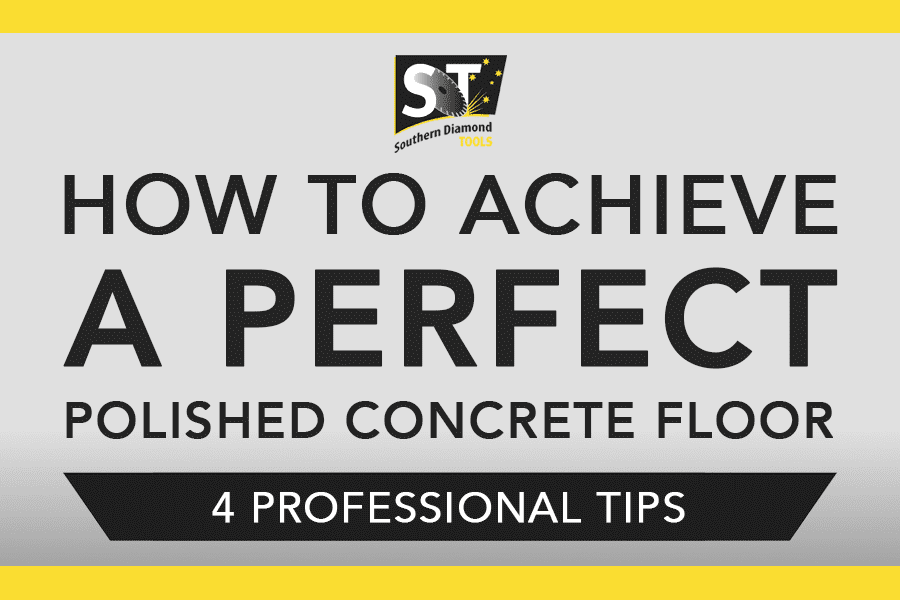Polished concrete is a high end and environmentally viable flooring option gaining popularity. It is through a mechanical polishing process using a concrete polisher, that the level of exposed aggregate and gloss level of a polished concrete floor is achieved. This first thing to consider before embarking on your concrete polishing journey is the level of exposure you are wanting to achieve, followed by the desired gloss level.
The exposure level of a polished concrete floor refers to the amount of aggregate visible after the first stages of metal diamond grinding. Different levels of aggregate exposure can be achieved depending on how deeply you grind the concrete surface. The colour, size and distribution of aggregate depends on where the concrete came from as well as how well it was installed and poured prior to polishing.
The different levels of concrete floor exposure include:
-
FULL STONE EXPOSURE
Exposes as much aggregate as possible and should be evenly consistent throughout the entire floor. Aggressive metal grinds are required to expose the aggregate prior to the concrete being polished. Usually a heavy grind with a #25-#30 grit will give the depth of cut to fully expose the aggregate in the concrete. As a result, this level of exposure is usually the most expensive and labour intensive.
-
MINIMAL EXPOSURE
Also known as a salt and pepper finish. Generally black and white specs will appear throughout this level of polished concrete floor finish. Small aggregate can also appear. Depending on how well the concrete was poured, some areas of the floor will have no stone exposure while some may have a little or a lot. The final amount of exposure is dependent on the initial flatness of the floor. If the concrete was poured well, there will be an even distribution throughout. This type of exposure requires a light metal grind either with a #60 or #120 metal diamond. Often used for an industrial look and considered a more cost effective option compared to full exposure floors.
-
ZERO EXPOSURE
Also known as a surface polish, zero exposure floors skip the metal grinding stages and move directly to the polishing stages with a resin bonded diamond. There will be zero aggregate exposed in this style of polished concrete floor. Achieving a minimalist look, you would usually start with a #100 grit resin bonded diamond. Like all polished concrete finishes, it will provide a beautiful and long lasting economical surface.
TIP 1: FLATNESS
To achieve a stunning polished concrete floor, it must be flat. The flatter the floor the better the results, as when you polish an uneven surface it will have noticeable ridges in it. The gloss level can also vary between the high and low spots giving it an inconsistent appearance. Consider this – why is a stone bench top so perfect in its appearance and gloss consistency? One of the reasons is it is perfectly flat!
TIP 2: EDGE FINISHING
Do not allow bad edges to destroy a successfully polished concrete floor. Develop your skills to produce beautifully blended edges. Good edges will be rewarded at the end of the job, ensuring your polished concrete floor is a success.
Planning the timing of construction with your edge work before walls, toilets and cabinetry are installed is incredibly important and beneficial. This will give the concrete floor a more even and uniform finish once polished.
TIP 3: GROUTING
Remember tip 1? For your concrete surface to achieve a stunning polished finish, it must be flat. Equally, it must have all the pin holes, bubbles and blow outs filled. When these voids are not filled the floor will appear dull and full of holes in natural light.
Mechanical grouting is achieved at the final metal grinding stage, using a #100-#120 grit metal diamond. Wetting the floor, applying the grout formula and passing over it with your concrete grinder at a slow speed will make a slurry type mix of water, grout and dust from the grinding process which will fill these voids.
TIP 4: DENSIFYING
In order to achieve a consistently even and high gloss surface, densifying is critical. Densifying is a chemical process that hardens the concrete floor, giving it the ability to reach its maximum hardness. Densifying, otherwise known as concrete hardening, is carried out by using a liquid chemical hardener made from sodium, lithium or potassium based silicates.
It is common practice to densify concrete after the grinding and grouting stages. This is done by applying a flood coat of densifier after the initial grouting process followed by “lick coats” of densifier in-between the concrete polishing stages. This will continue to harden the concrete floor until an even shine or gloss is achieved, without any blotching.
Remember, the harder the surface the better the polishing and the stronger and more durable the final polished concrete surface will become.
Once you have completed the metal diamond grinding, grouting and densifying processes you are now ready to commence the concrete polishing process. This is done using resin bonded diamonds – #50, #100, #200, #400, #800, #1500 and #3000. The level of gloss is determined by the stage at which you cease polishing in the concrete polishing process. Full high gloss is achieved between #800, #1500 and #3000 resin polishing stages.
Don’t forget to blend your edges with each stage of the polishing process to ensure a consistent appearance across the whole floor.
We hope these professional tips will be of great use to you throughout your concrete polishing journey. If you have any further questions, please do not hesitate to contact us here.
Written By: John Aquila (Director of Southern Diamond Tools)




